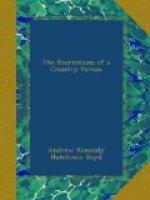has a great deal to say in defence of his views.
I am obliged to acknowledge that in many cases important
benefits would follow the adoption of urn-sepulture.
The question to be considered is, what is the best
way to dispose of the mortal part of man when the
soul has left it? A first suggestion might be
to endeavour to preserve it in the form and features
of life; and, accordingly, in many countries and ages,
embalming in its various modifications has been resorted
to. But all attempts to prevent the human frame
from obeying the Creator’s law of returning
to the elements have miserably failed. And surely
it is better a thousand times to ‘bury the dead
from our sight,’ than to preserve a hideous
and revolting mockery of the beloved form. The
Egyptian mummies every one has heard of; but the most
remarkable instance of embalming in recent times is
that of the wife of one Martin Van Butchell, who,
by her husband’s desire, was embalmed in the
year 1775, by Dr. William Hunter and Mr. Carpenter,
and who may be seen in the museum of the Royal College
of Surgeons in London. She was a beautiful woman,
and all that skill and science could do were done
to preserve her in the appearance of life; but the
result is nothing short of shocking and awful.
Taking it, then, as admitted, that the body must return
to the dust from whence it was taken, the next question
is, How? How shall dissolution take place with
due respect to the dead, and with least harm to the
health and the feelings of the living?
The two fashions which have been universally used
are, burial and burning. It has so happened that
burial has been associated with Christianity, and
burning with heathenism; but I shall admit at once
that the association is not essential, though it would
be hard, without very weighty reason indeed, to deviate
from the long-remembered ‘earth to earth, ashes
to ashes, dust to dust.’ But such weighty
reason the author of this treatise declares to exist.
The system of burial, he says, is productive of fearful
and numberless evils and dangers to the living.
In the neighbourhood of any large burying-place, the
air which the living breathe, and the water which
they drink, are impregnated with poisons the most destructive
of health and life. Even where the damage done
to air and water is inappreciable by our senses, it
is a predisposing cause of headache, dysentery, sore
throat, and low fever;’ and it keeps all the
population around in a condition in which they are
the ready prey of all forms of disease. I shall
not shock my readers by relating a host of horrible
facts, proved by indisputable evidence, which are
adduced by the surgeon to show the evils of burial:
and all these evils, he maintains, may be escaped
by the revival of burning. Four thousand human
beings die every hour; and only by that swift and
certain method can the vast mass of decaying matter
which, while decaying, gives off the most subtle and
searching poisons, be resolved with the elements without




